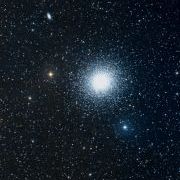|
Advertisement / Annons: |
Astronomy Science data |
Content: |
POSS-I dataIn the early 2000s I asked my teacher prof Gösta Gahm where I could find useable data from professional telescopes. The he told me that the POSS-I (Palomar Observatory Sky Survey) data base could be a good place to look at. The photographic plates in this data base contains red and blue spectra photographic plates. These plate was taken between the years 1948 to 1958, the word digital cameras wasn't invented yet. This could be what your grandfather was working with if he was an astronomer. If you have a big fullframe camera today, compare to this, 355 mm x 355 mm dimension of the photographic plate, it's like 150 fullframe cameras! When I have done these color images of the Messier objects I have to do something about the missing green channel. I did it very simple, just make an new channel by the average from the red and blue plates. The red and blue plates doesn't correspond very well to your digital cameras red and blue filters. It's more what the emulsion was sensitive to. |
Mount Palomar's Samuel Oschin TelescopeFrom where did these POSS-I data came from? It's from one of the biggest Schmidt telescopes in the world, Samuel Oschin Telescope at Mount Palomar. It's a 48" f/2.5 big opening telescope or Schmidt astrograph, because this isn't a telescope to look through, only wide field photographing. Still in use today but now rebuilt to take digital CDD cameras. You can read more about this fantastic camera here: I can tell you that I have a similar telescope like that just 30 km away from where I live in Sweden. It's the observatory Saltsjöbaden who let built a 40" Schmidt camera in the 1960s, it wasn't very clever, because it's too close to the capital city Stockholm. Mount Palomar are at elevation 2000 m, Saltsjöbaden at 100 m. Below you see what images I had processed, click on the images and get more deeper information: |
|||
 |
 |
 |
 |
| Messier 1 Crab Nebula |
Messier 13 Hercules Globular Cluster |
Messier 31 Andromeda Galaxy |
Messier 42 Orion Nebula |
 |
|||
| Messier 45 Pleiades |
|||
| Images from POSS-I plates, credits: STScI Image processing by Lars Karlsson |
|||
Conclusion:These images has a huge fov, I have only used a small portion of it. The dynamic range seems to be low, all brighter parts are oversaturated. Todays technique with a lot of sub images has a lot of advantages, better dynamics and less problem with drift, but digital sensors are very small compare to the photographic plates they had at that time. |
| Go Back to content |
| Go Back |